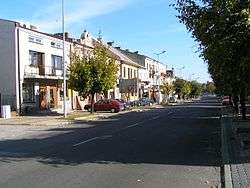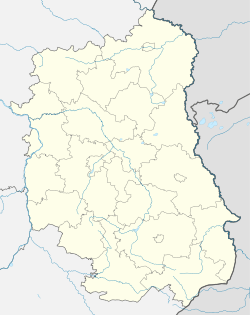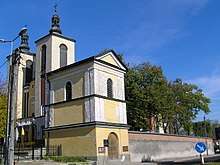Piaski
Piaski (Polish pronunciation: [ˈpjaskʲi]), formerly Piaski Luterskie, is a town in Poland at the Giełczew river. The town's population is about 2,660 (2004). Administratively it belongs to Świdnik County of the Lublin Voivodeship. It lies 16 km southeast of Świdnik.
Piaski | |
|---|---|
 Main thoroughfare in Piaski | |
 Coat of arms | |
 Piaski  Piaski | |
| Coordinates: 51°8′3″N 22°50′41″E | |
| Country | |
| Voivodeship | Lublin |
| County | Świdnik |
| Gmina | Piaski |
| First mentioned | 1401 |
| Town rights | 15th century |
| Government | |
| • Mayor | Ryszard Siczek |
| Area | |
| • Total | 8.43 km2 (3.25 sq mi) |
| Population (2006) | |
| • Total | 2,626 |
| • Density | 310/km2 (810/sq mi) |
| Time zone | UTC+1 (CET) |
| • Summer (DST) | UTC+2 (CEST) |
| Postal code | 21-050 |
| Car plates | LSW |
| Website | www.piaski.pl |
History

The first mention of the village located near the site of the current town and called Pogorzały Staw comes from the 1401 document. The first specific mention of Piaski occurs in the Latin chronicle of Jan Długosz from 1470 which calls the town "Pyassek alias Gyelczew" (alias here meaning formerly), where Giełczew is the name of another local village. Based on this evidence, it is thought that the town of Piaski came into existence some time in the first half of the 15th century on the lands formerly belonging to those two villages. In the 16th and 17th centuries a significant part of the town's population was Protestant, hence it became known as Piaski Luterskie (Lutheran).
Eventually, the town's Jewish community grew to eventually constitute two thirds of the total inhabitants. In 1795 during the Third Partition of Poland, the town became part of Habsburg Austria. In 1809 it briefly passed to the Polish Duchy of Warsaw, before becoming part of Congress Poland under Russian rule from 1815 onward. In 1869 Piaski lost its municipal rights as punishment for the January Uprising. After World War I, since 1918 it has belonged to reconstituted sovereign Poland. In 1921, Piaski had 2,674 Jews among its 3,974 inhabitants.
World War II
During the invasion of Poland, which started World War II, Germany raided the town four times in September 1939.[1] A dozen or so people were killed, and many buildings were destroyed, however, thanks to firefighters and civil defense the damage was limited.[1]
During the German occupation of Poland, the town became part of the semi-colonial General Government, established by the Nazi German regime in central Poland. At the beginning of this period, 4,165 Jews resided in Piaski. After the brief Soviet occupation in September 1939, many Jews fled east with the Soviet army. In 1940 the Nazi German occupiers established the Piaski ghetto, to imprison not only its Jewish inhabitants, but also several thousand Jews transported from the Lublin Ghetto, the German Reich and German-occupied Czechoslovakia. In addition to housing Piaski Jews, Piaski was a transit ghetto where thousands of Jews were located on their way to the death at the nearby Bełżec extermination camp.[2] Severe overcrowding, hunger, and the lack of a secure water supply and sanitation led to a typhus epidemic in late 1941 that killed as many as 1500 ghetto residents. In early 1942, thousands of Jews were marched to nearby Trawniki and many died there en route to Belzec. The Polish underground resistance movement organized secret help for Jews through the Council to Aid Jews, better known as Żegota.[1]
In the second half of 1942, remaining Piaski Jews were taken to Trawniki and then by Holocaust trains to Sobibor where they were immediately murdered. The liquidation of the ghetto was aided by the Reserve Police Battalion 101 from Hamburg. The number of Piaski Jews who survived is unknown, but the Jewish community ceased to exist.[3] After the war, one family, the Podsiadlys, were named Righteous Among the Nations by Yad Vashem, for protecting Kurt Ticho Thomas who had escaped from Sobibor.[4]
Recent period
In 1993 Piaski recovered its municipal rights, officially becoming a town again after a break of over a hundred years.

In 2007 a monument to Józef Franczak, the last partisan of the anti-communist resistance in Poland, who is buried at the local cemetery, was unveiled in Piaski.[5]
Facilities
Near Piaski there is a TV transmission site, with a 342-metre-high (1,122 ft) guyed mast, one of the tallest in Poland.
Notable people
- Andrzej Zaorski (born 1942), actor and cabaret artist
- Antoni Norbert Patek de Prawdzic (born 1812), watchmaker, co-founder of Patek Philippe
Notes
- "Historia". Gmina Piaski (in Polish). Retrieved 15 August 2020.
- https://collections.ushmm.org/search/catalog/irn507303
- Browning 1998, pp. 51–53.
- Megargee, Geoffrey (2012). Encyclopedia of Camps and Ghettos. Bloomington, Indiana: University of Indiana Press. p. Volume II 696-699. ISBN 978-0-253-35599-7.
- "Odsłonięcie pomnika Józefa Franczaka ps. Lalek – Piaski, 11 maja 2007 r." Instytut Pamięci Narodowej (in Polish). Retrieved 15 August 2020.
References
- Browning, Christopher R. (2001). "Arrival in Poland". Ordinary Men: Reserve Police Battalion 101 and the Final Solution in Poland (PDF). United Kingdom: Penguin Books. p. 49. ISBN 9780141000428. OCLC 838611906. Archived from the original (PDF file, direct download 7.91 MB) on 2013-10-19.
- "Official webpage: Town History" (in Polish). Urząd Miejski w Piaskach. 27 February 2013.
- "The Piaski Ghetto. Town history". Survivors, Rabbis of Piaski, Righteous Gentiles. Remember Jewish Piaski - Genealogy Group. 2014. Retrieved 24 July 2014. With selection of period photographs, list of references and relevant weblinks.
- Dane Głównego Urzędu Statystycznego: Ludność. Stan i struktura w przekroju terytorialnym. Stan w dniu 31 XII 2008 r.